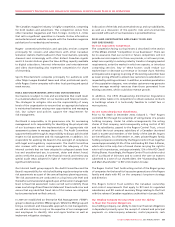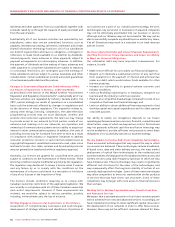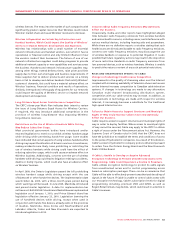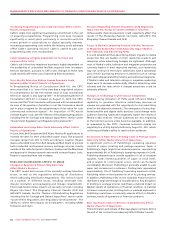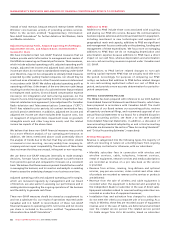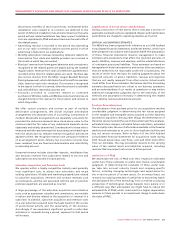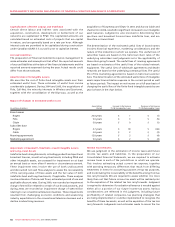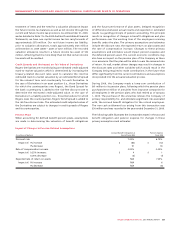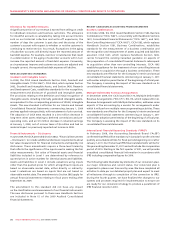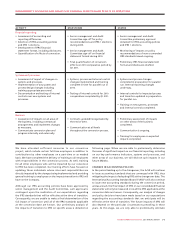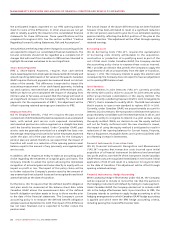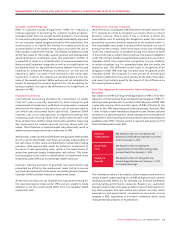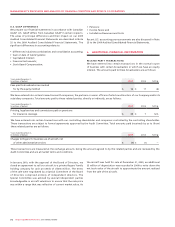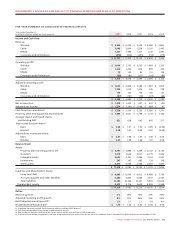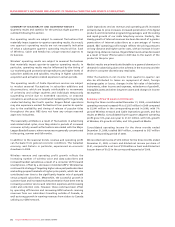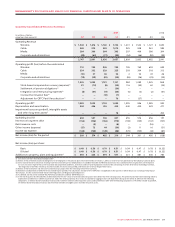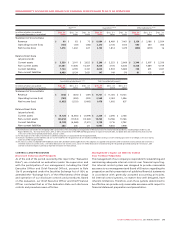Rogers 2009 Annual Report Download - page 65
Download and view the complete annual report
Please find page 65 of the 2009 Rogers annual report below. You can navigate through the pages in the report by either clicking on the pages listed below, or by using the keyword search tool below to find specific information within the annual report.
ROGERS COMMUNICATIONS INC. 2009 ANNUAL REPORT 69
MANAGEMENT’S DISCUSSION AND ANALYSIS OF FINANCIAL CONDITION AND RESULTS OF OPERATIONS
treatment of items and the need for a valuation allowance impact
the future income tax balances as well as net income through the
current and future income tax provisions. As at December 31, 2009,
and as detailed in Note 7 to the 2009 Audited Consolidated Financial
Statements, we have non-capital income tax loss carryforwards of
approximately $370 million. Our net future income tax liability,
prior to valuation allowances, totals approximately $125 million
at December 31, 2009 (2008 – asset of $251 million). The recorded
valuation allowance results in a future income tax asset of $52
million, reflecting that it is more likely than not that certain income
tax assets will be realized.
Credit Spreads and the Impact on Fair Value of Derivatives
Rogers’ Derivatives are recorded using an estimated credit-adjusted
mark-to-market valuation which is determined by increasing the
treasury-related discount rates used to calculate the risk-free
estimated mark-to-market valuation by an estimated Bond Spread
for the relevant term and counterparty for each Derivative. In
the case of Derivatives in an asset position (i.e., those Derivatives
for which the counterparties owe Rogers), the Bond Spread for
the bank counterparty is added to the risk-free discount rate to
determine the estimated credit-adjusted value. In the case of
Derivatives in a liability position (i.e., those Derivatives for which
Rogers owes the counterparties), Rogers’ Bond Spread is added to
the risk-free discount rate. The estimated credit-adjusted values of
the Derivatives are subject to changes in credit spreads of Rogers
and its counterparties.
Pension Plans
When accounting for defined benefit pension plans, assumptions
are made in determining the valuation of benefit obligations
and the future performance of plan assets. Delayed recognition
of differences between actual results and expected or estimated
results is a guiding principle of pension accounting. This principle
results in recognition of changes in benefit obligations and plan
performance over the working lives of the employees receiving
benefits under the plan. The primary assumptions and estimates
include the discount rate, the expected return on plan assets and
the rate of compensation increase. Changes to these primary
assumptions and estimates would impact pension expense and
the deferred pension asset. The current economic conditions may
also have an impact on the pension plan of the Company as there
is no assurance that the plan will be able to earn the assumed rate
of return. As well, market driven changes may result in changes in
the discount rates and other variables which would result in the
Company being required to make contributions in the future that
differ significantly from the current contributions and assumptions
incorporated into the actuarial valuation process.
During 2009, the Company made a lump-sum contribution of
$61 million to its pension plans, following which the pension plans
purchased $172 million of annuities from insurance companies for
all employees in the pension plans who had retired as of January
1, 2009. The purchase of the annuities relieves the Company of
primary responsibility for, and eliminates significant risk associated
with, the accrued benefit obligation for the retired employees.
The non-cash settlement loss arising from this transaction was
$30 million and was recorded in the year ended December 31, 2009.
The following table illustrates the increase (decrease) in the accrued
benefit obligation and pension expense for changes in these
primary assumptions and estimates:
(In millions of dollars)
Accrued Benefit Obligation at
End of Fiscal 2009
Pension Expense
Fiscal 2009
Discount rate 7.20% 6.75%
Impact of: 1% increase $ (83) $ (12)
1% decrease 91 18
Rate of compensation increase 3.00% 3.00%
Impact of: 0.25% increase: $ 4 $ 1
0.25% decrease (4) (1)
Expected rate of return on assets N/A 7.25%
Impact of: 1% increase N/A 6
1% decrease N/A (6)
Impact of Changes in Pension-Related Assumptions


